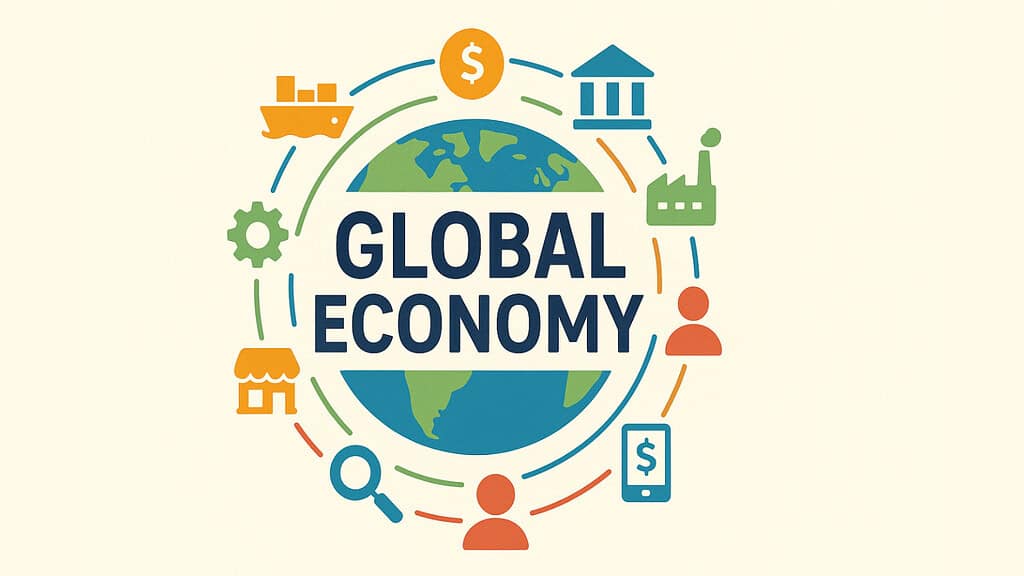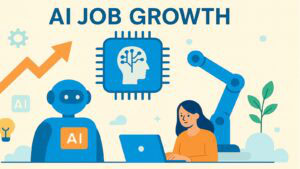Table of Contents
Introduction: Understanding the Global Economy at Its Core
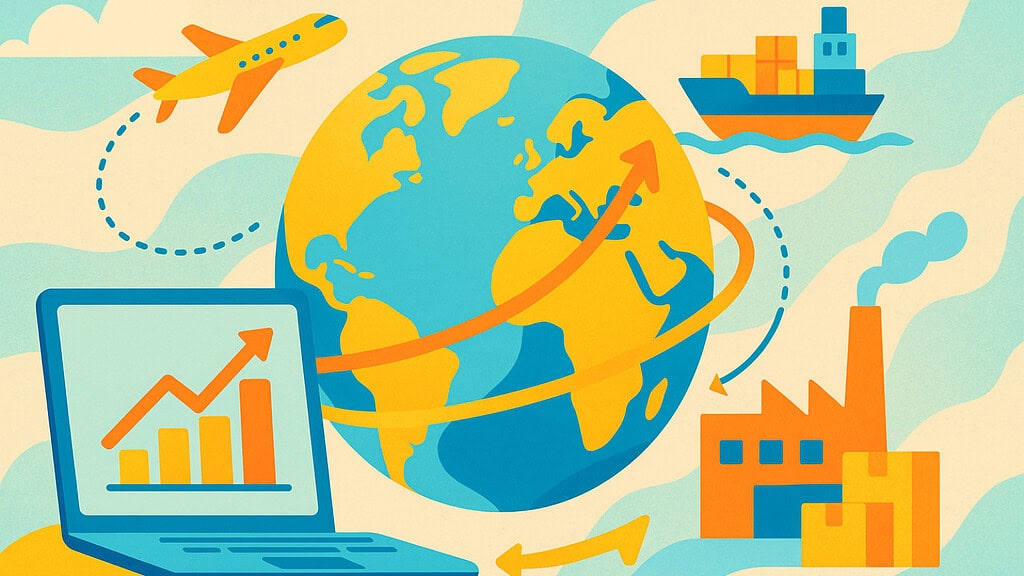

The global economy shapes your morning coffee, your smartphone, and even the job market in your hometown. Every transaction, every investment, and every trade decision ripples across continents in ways that connect distant strangers through invisible threads of commerce. Understanding these connections has never been more crucial as we navigate an increasingly complex world where local events trigger global consequences.
At its essence, the global economy represents the intricate web of trade, finance, labor, and resources that binds nations together. It encompasses everything from a farmer in Kenya selling coffee beans to a tech company in Silicon Valley, from oil flowing through Middle Eastern pipelines to remittances sent by migrant workers to their families thousands of miles away. This interconnected system operates on principles that determine prosperity, influence political stability, and shape the future of billions of people.
The complexity can seem overwhelming, but the global economy rests on ten fundamental building blocks that work together like gears in a vast machine. These elements influence each other in ways that create opportunities and challenges, growth and disruption, cooperation and conflict. By examining these building blocks of the global economy, we can better understand how decisions made in boardrooms and government offices affect everyday lives across the globe.
Table 1: Global Economy Key Indicators (2024)
| Indicator | Value | Growth Rate |
|---|---|---|
| Global Trade Volume | $33 trillion | +3.7% |
| Services Trade Growth | N/A | +9.0% |
| Remittances to LMICs | $685 billion | +5.8% |
| G20 Exports (Q1 2025) | N/A | +2.0% |
| G20 Imports (Q1 2025) | N/A | +3.1% |
Source: UNCTAD Global Trade Update, World Bank Migration Brief
1. Global Trade in Goods and Services: The Global Economy’s Lifeblood

Trade forms the circulatory system of the global economy, pumping goods and services across borders with relentless efficiency. When you sip Colombian coffee in New York or use a smartphone assembled in China with components from dozens of countries, you participate in this vast network that has grown exponentially over recent decades.
The mechanics of international trade reveal fascinating patterns. Countries export what they produce efficiently and import what others make better or cheaper. This principle, known as comparative advantage, explains why Saudi Arabia exports oil while importing electronics, or why Germany exports machinery while importing tropical fruits. The system creates mutual dependence that generally promotes peace and cooperation, though it also creates vulnerabilities when supply chains face disruption.
In 2024, global trade achieved an unprecedented $33 trillion, marking a 3.7% increase and contributing an additional $1.2 trillion to the global economy. This expansion reflects significant resilience in the face of persistent geopolitical tensions and supply chain difficulties. Services drove much of this expansion, rising 9% for the year, highlighting how digital transformation has made intangible products increasingly tradeable across borders.
Modern trade encompasses far more than physical goods crossing borders. Financial services, software, entertainment, and consulting now flow globally as easily as manufactured products once did. A software developer in India can serve clients in Europe, while a design firm in Denmark creates products manufactured in Vietnam for American consumers. This evolution has democratized participation in global markets, allowing smaller countries and companies to find niches in the worldwide marketplace.
Supply chains have become intricate networks spanning multiple continents. A single automobile might contain steel from Brazil, electronics from South Korea, rubber from Malaysia, and be assembled in Mexico for sale in the United States. This complexity creates efficiency and cost savings but also introduces fragility when disruptions occur anywhere along the chain.
Table 2: Major Global Trade Flows by Category (2024)
| Trade Category | Volume/Value | Key Characteristics |
|---|---|---|
| Manufacturing Goods | $25.8 trillion | Traditional backbone of global trade |
| Services Trade | $7.2 trillion | Fastest growing segment |
| Digital Services | $3.8 trillion | Enabled by technology advancement |
| Energy Products | $4.2 trillion | Geopolitically sensitive |
| Agricultural Products | $2.1 trillion | Essential for food security |
Source: UNCTAD, World Trade Organization estimates
2. Global Financial Systems and Capital Flows in the Global Economy
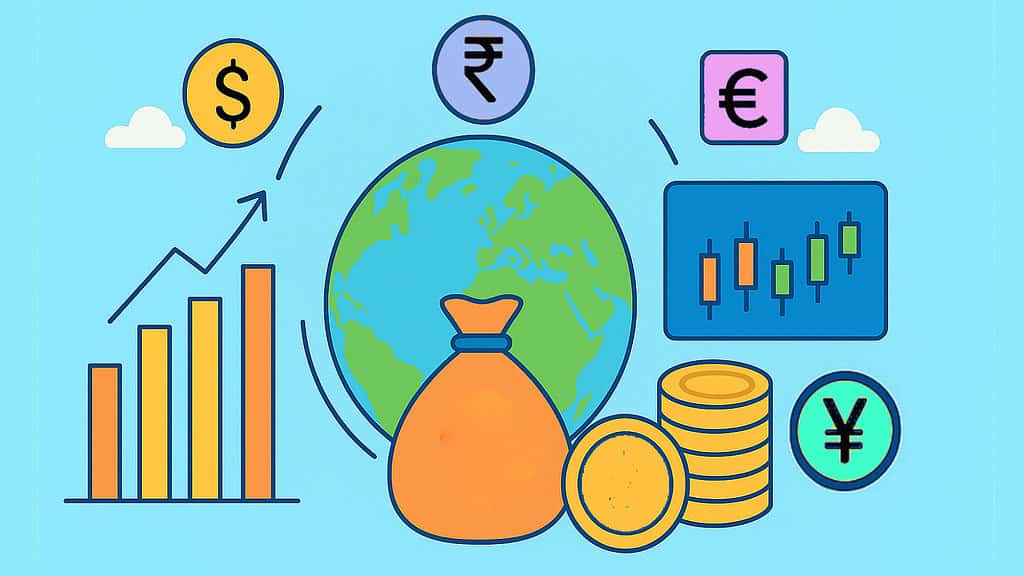
Money flows across borders like water finding its level, seeking the highest returns and most promising opportunities. This financial circulation system enables investment, facilitates trade, and spreads both prosperity and risk throughout the global economy. Understanding these flows reveals how capital markets connect every corner of the world through invisible but powerful channels.
International finance operates through multiple layers of complexity. Foreign direct investment moves when companies build factories or acquire businesses abroad. Portfolio investment flows as investors buy stocks and bonds in foreign markets. Short-term capital darts between countries chasing interest rate differentials or currency movements. Each type of flow serves different purposes and responds to different incentives, creating a dynamic system that never sleeps.
Stock markets in New York, London, Tokyo, and emerging centers like Mumbai and São Paulo operate in continuous cycles, with trading passing from one time zone to the next. When American markets close, Asian markets open, creating a 24-hour global trading environment. This interconnectedness means that events in one market quickly influence others, as investors adjust portfolios based on worldwide developments.
Foreign exchange markets dwarf all other financial markets in size and importance. Daily trading volumes exceed $7 trillion, making currency markets the most liquid in the world. Exchange rates affect everything from import prices to tourist expenses, influencing inflation, competitiveness, and economic growth. Central banks intervene in these markets to stabilize their currencies, but market forces ultimately determine value relationships between major currencies.
Debt markets have globalized extensively, with governments and corporations issuing bonds in multiple currencies to diverse international investor bases. This diversification provides access to capital but also creates new vulnerabilities. When investor sentiment shifts, capital can flee quickly, leaving borrowing countries scrambling to find alternative financing sources.
Table 3: Global Capital Flow Categories (2024) In Global Economy
| Flow Type | Estimated Volume | Primary Drivers |
|---|---|---|
| Foreign Direct Investment | $1.5 trillion | Long-term business opportunities |
| Portfolio Investment | $8.2 trillion | Return differentials and risk appetite |
| Bank Lending | $4.1 trillion | Trade finance and corporate credit |
| Currency Trading | $7.5 trillion daily | Hedging and speculation |
| Sovereign Debt | $12.8 trillion | Government financing needs |
Source: Bank for International Settlements, International Monetary Fund
3. Labor Migration: Workers Powering the Global Economy

Human movement across borders creates some of the most profound and personal connections in the global economy. When individuals move to new locations for work, they bring with them a set of skills, aspirations, and cultural viewpoints that enhance the richness of both their home and host nations. The money they send home, known as remittances, often exceeds foreign aid and represents lifelines for families and entire communities.
Patterns of labor migration reveal the global economy’s labor demands and opportunities. High-skilled workers move toward technology centers and financial hubs, while agricultural and construction workers follow seasonal demands and infrastructure projects. This movement helps balance labor markets globally, though it also creates social and political tensions in receiving countries.
Remittances to low- and middle-income countries reached $685 billion in 2024, representing flows larger than foreign direct investment and official development assistance combined. These transfers demonstrate the economic impact of human migration on a massive scale. The rate of growth for remittances increased to 5.8 percent in 2024, a substantial rise compared to the 1.2 percent recorded in 2023.
The economics of migration create complex feedback loops. Countries losing workers may suffer brain drain but benefit from reduced unemployment and increased remittances. Receiving countries gain workers and innovation but face integration challenges and potential wage pressures. These dynamics play out differently across skill levels and geographic regions, creating diverse migration experiences.
Temporary migration programs have become increasingly important as countries seek to balance labor needs with concerns about permanent settlement. Seasonal agricultural workers, temporary skilled professionals, and circular migration patterns allow countries to access foreign workers while maintaining greater control over long-term demographic changes.
Digital technology has created new forms of migration that don’t require physical movement. Remote work arrangements allow people to serve global markets while remaining in their home countries. This virtual migration could reshape traditional patterns and reduce some pressures for physical relocation while creating new opportunities for developing countries.
Table 4: Global Migration and Remittances Overview (2024)
| Migration Metric | Volume/Value | Economic Impact |
|---|---|---|
| International Migrants | 281 million | 3.6% of global population |
| Remittances to LMICs | $685 billion | Exceeds FDI flows |
| High-Skilled Migration | 87 million | Drives innovation centers |
| Seasonal Workers | 164 million | Supports agricultural cycles |
| Refugee Population | 35.3 million | Humanitarian and economic challenge |
Source: World Bank Migration Brief, International Organization for Migration
4. Global Tech Innovation: Transforming the Global Economy
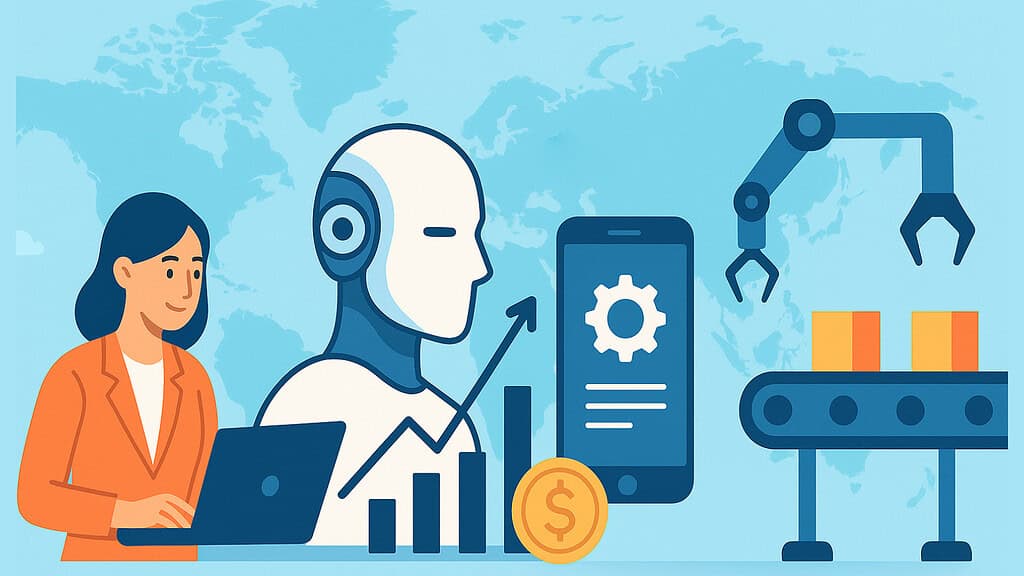
Technology acts as both the engine and transmission system of the modern global economy, accelerating change and connecting previously isolated markets. Digital innovation has collapsed distance and time barriers, enabling instant communication, automated production, and new business models that operate across borders with unprecedented efficiency.
Artificial intelligence and automation are reshaping production processes worldwide. Factories use robots for precision manufacturing while algorithms optimize supply chains and predict demand patterns. This technological evolution affects employment differently across countries, with some benefiting from new high-skilled opportunities while others face displacement of traditional manufacturing jobs.
The internet has created entirely new categories of global trade. Software, digital content, online services, and data analytics can be produced in one country and consumed instantly worldwide. This democratization of market access allows small companies in developing countries to serve customers globally, though it also intensifies competition across all markets.
Blockchain technology and digital currencies are beginning to transform international payments and trade finance. These innovations could reduce transaction costs and settlement times while creating new regulatory challenges for governments trying to maintain oversight of cross-border financial flows.
E-commerce platforms have revolutionized how businesses reach international customers. Small manufacturers can now access global markets through online marketplaces, while consumers can purchase products from anywhere in the world. This direct connectivity bypasses traditional intermediaries but creates new dependencies on digital infrastructure and logistics networks.
Research and development increasingly occurs through international collaboration, with companies and universities forming partnerships that span continents. This global approach to innovation accelerates technological progress but also creates concerns about intellectual property protection and technology transfer.
Table 5: Technology Impact on Global Economy (2024)
| Technology Sector | Global Value | Transformation Impact |
|---|---|---|
| Digital Services Trade | $3.8 trillion | Enables borderless commerce |
| E-commerce Platforms | $6.2 trillion | Connects global consumers |
| AI and Automation | $2.6 trillion | Reshapes production processes |
| Blockchain Applications | $0.4 trillion | Transforms payment systems |
| Cloud Computing | $0.8 trillion | Enables global digital services |
Source: McKinsey Global Institute, World Trade Organization Digital Economy Report
5. Natural Resources and Energy Driving the Global Economy
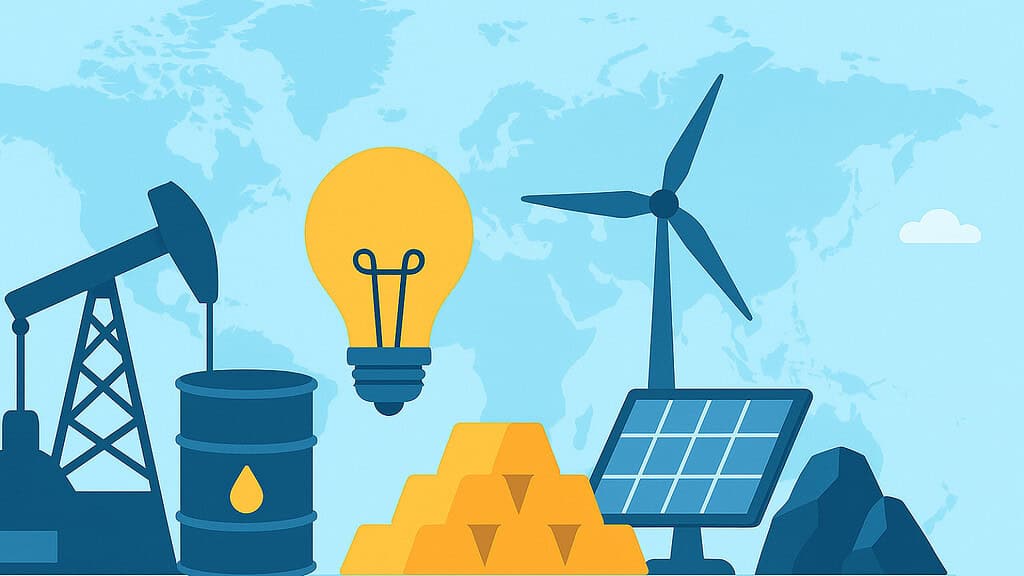
Natural resources form the foundation upon which all economic activity rests. Energy powers factories and transportation systems, minerals provide raw materials for manufacturing, and agricultural products feed the world’s population. Access to these resources shapes national strategies, influences international relationships, and drives both cooperation and conflict across the globe.
Oil remains the most geopolitically significant commodity, with price fluctuations affecting inflation rates, trade balances, and economic growth worldwide. Major oil-producing regions wield enormous influence over global economic conditions, while consuming countries must balance energy security concerns with environmental goals and cost considerations.
The transition toward renewable energy is reshaping global resource flows and creating new dependencies. Solar panels require rare earth minerals, wind turbines need specific metal alloys, and battery production depends on lithium and cobalt deposits. This shift is creating new resource bottlenecks and changing the geography of energy power from traditional oil producers toward countries rich in critical minerals.
Food security concerns have elevated agriculture to strategic importance as climate change affects growing conditions and population growth increases demand. Countries are investing in agricultural technology and securing long-term supply agreements to ensure stable food supplies for their populations.
Water scarcity affects over two billion people and creates another dimension of resource competition. Countries sharing river systems must negotiate water usage rights, while technology companies invest in desalination and water recycling to support industrial operations in arid regions.
The circular economy concept is gaining traction as countries and companies seek to reduce waste and maximize resource efficiency. Recycling programs, remanufacturing initiatives, and design-for-durability approaches aim to reduce dependence on virgin resources while creating new economic opportunities.
Table 6: Global Natural Resource Dependencies (2024)
| Resource Category | Annual Consumption | Strategic Importance |
|---|---|---|
| Crude Oil | 102 million barrels/day | Energy security and inflation |
| Natural Gas | 4.1 trillion cubic meters | Industrial heating and power |
| Critical Minerals | $320 billion | Technology and green transition |
| Agricultural Products | $2.1 trillion | Food security and nutrition |
| Fresh Water | 4.6 trillion cubic meters | Industrial and human needs |
Source: International Energy Agency, Food and Agriculture Organization
6. Governance and Institutions Shaping the Global Economy
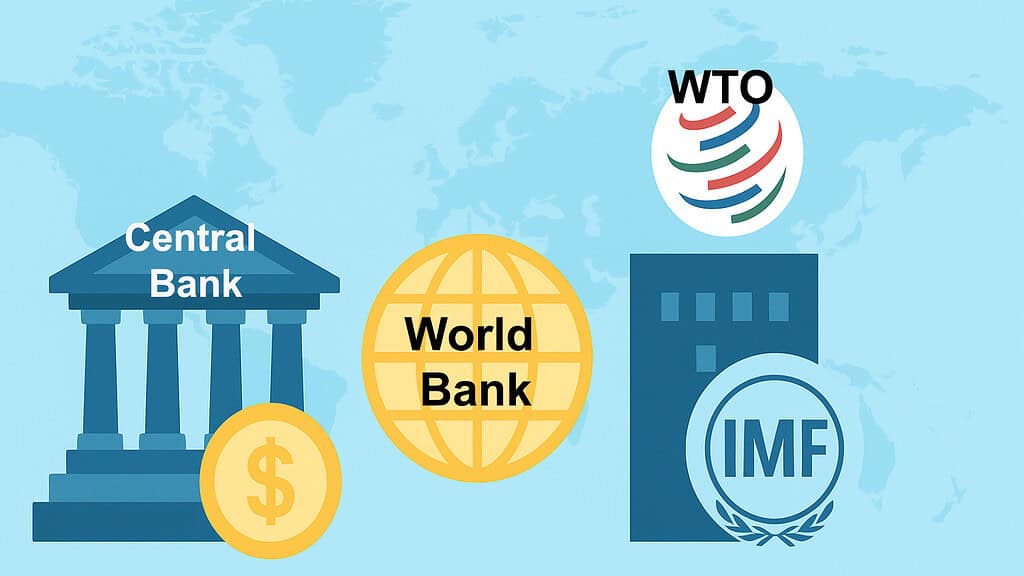
International institutions provide the rules, forums, and mechanisms that allow the global economy to function despite the absence of a world government. These organizations facilitate cooperation, resolve disputes, and coordinate responses to global challenges, though their effectiveness often depends on the willingness of member countries to comply with agreements and commitments.
The International Monetary Fund serves as the global economy’s emergency responder, providing financial assistance to countries facing balance of payments crises. Its lending programs come with policy conditions designed to restore economic stability, though these requirements sometimes generate controversy about sovereignty and social impact.
The World Trade Organization oversees global trade rules and provides mechanisms for resolving trade disputes between countries. Its principles of non-discrimination and reciprocity have facilitated trade growth, but the organization faces challenges from rising protectionism and difficulty reaching new multilateral agreements.
The World Bank focuses on development finance, providing loans and grants for infrastructure projects, poverty reduction programs, and capacity building in developing countries. Its role has evolved to address climate change, governance issues, and sustainable development goals beyond traditional economic growth metrics.
Regional organizations like the European Union, ASEAN, and USMCA create deeper economic integration among neighboring countries. These arrangements often involve more extensive commitments than global institutions can achieve, including common regulations, shared institutions, and coordinated policies.
The G20 provides a forum for the world’s largest economies to coordinate macroeconomic policies and address global challenges. While it lacks formal authority, the group’s collective economic weight gives its decisions significant influence over global economic conditions.
Table 7: Key Global Economic Institutions (2024)
| Institution | Primary Role | Member Countries |
|---|---|---|
| International Monetary Fund | Financial stability and crisis assistance | 190 members |
| World Trade Organization | Trade rules and dispute resolution | 164 members |
| World Bank Group | Development finance and poverty reduction | 189 members |
| Bank for International Settlements | Central bank cooperation | 63 central banks |
| G20 Forum | Economic policy coordination | 20 major economies |
Source: Official institutional websites and membership data
7. Globalization and Supply Chains in the Global Economy
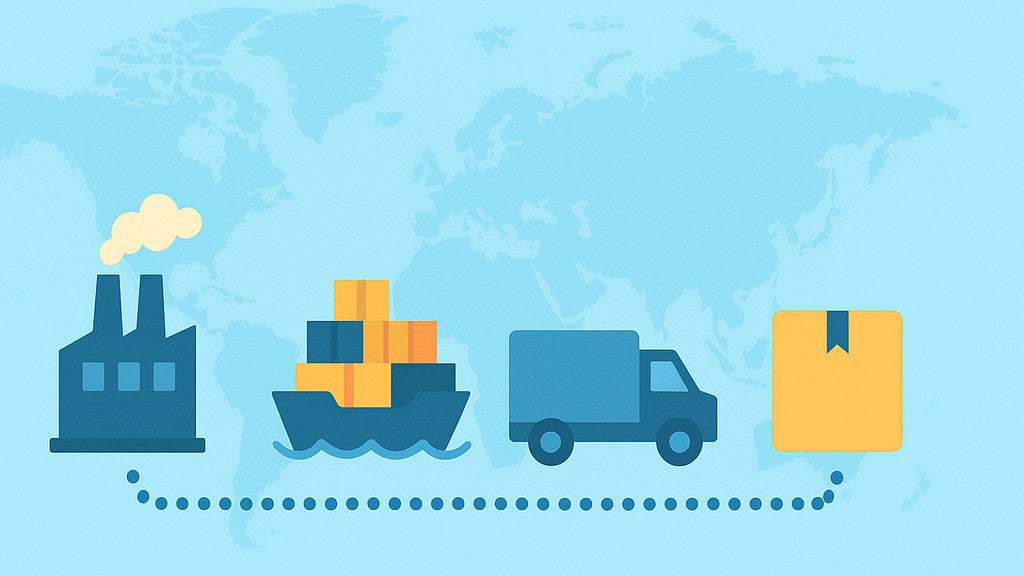
Supply chains represent the nervous system of globalization, connecting raw materials to finished products through networks that span continents and involve hundreds of companies. These systems have created unprecedented efficiency and cost reduction but also introduced vulnerabilities that can disrupt entire industries when key links fail.
The automobile industry exemplifies supply chain complexity, with vehicles containing parts from dozens of countries assembled in sequences that require precise timing and coordination. A semiconductor shortage can halt production lines worldwide, while a port closure in one country affects deliveries thousands of miles away.
Just-in-time manufacturing has reduced inventory costs but increased sensitivity to disruptions. Companies maintain minimal stock levels and rely on suppliers to deliver components exactly when needed. This efficiency comes at the cost of resilience, as any interruption in the supply chain can quickly halt production.
Digital technology enables supply chain coordination through real-time tracking, predictive analytics, and automated reordering systems. Companies can monitor shipments globally, anticipate demand fluctuations, and optimize routing decisions to minimize costs and delivery times.
The COVID-19 pandemic exposed supply chain vulnerabilities and prompted many companies to reassess their strategies. Some are reshoring production closer to major markets, while others are diversifying supplier bases to reduce dependence on single sources or countries.
Environmental concerns are driving supply chain transparency initiatives as companies face pressure to ensure sustainable practices throughout their networks. This responsibility extends from resource extraction through manufacturing to end-of-life disposal, requiring cooperation across multiple countries and industries.
Table 8: Global Supply Chain Characteristics (2024)
| Supply Chain Element | Global Scope | Vulnerability Factors |
|---|---|---|
| Manufacturing Networks | 195 countries | Concentration risks and disruptions |
| Shipping Routes | 90,000 vessels | Weather, piracy, and port capacity |
| Digital Logistics | $280 billion | Cyber security and system failures |
| Inventory Management | $8.1 trillion | Demand volatility and storage costs |
| Quality Control | 50,000 standards | Regulatory differences and compliance |
Source: World Shipping Council, International Chamber of Commerce
8. Geopolitics and Security Risks in the Global Economy

Political relationships between countries directly affect economic flows, investment decisions, and market access in ways that can override pure economic logic. Trade wars, sanctions, and security concerns create barriers that fragment the global economy and force companies to navigate complex political landscapes alongside business considerations.
Economic sanctions have become a preferred tool of foreign policy, allowing countries to pressure adversaries without military action. These measures can freeze assets, block financial transactions, and prohibit trade in specific goods or services. However, sanctions often have unintended consequences for third parties and can accelerate the development of alternative economic systems.
Cybersecurity threats pose increasing risks to global economic infrastructure as financial systems, supply chains, and communication networks become more digital and interconnected. State-sponsored attacks can target critical infrastructure, steal intellectual property, or disrupt commercial operations across multiple countries simultaneously.
Trade blocs and economic partnerships reflect geopolitical alignments as countries seek to strengthen ties with allies while reducing dependence on potential adversaries. These arrangements can create efficiency gains for members but may also divert trade from more economically optimal patterns.
Military conflicts disrupt regional and global economic flows even when fighting remains localized. War affects shipping routes, commodity supplies, and investor confidence while generating refugee flows that strain neighboring economies and require international assistance.
Energy security concerns influence foreign policy decisions and investment strategies as countries seek to diversify supply sources and reduce dependence on potentially unreliable partners. This diversification often involves higher costs but provides insurance against supply disruptions.
Table 9: Geopolitical Risks to Global Economy (2024)
| Risk Category | Economic Impact | Affected Sectors |
|---|---|---|
| Trade Tensions | $2.5 trillion in restricted flows | Technology, agriculture, manufacturing |
| Cyber Attacks | $8.4 trillion annual cost | Financial services, infrastructure |
| Regional Conflicts | $1.8 trillion in disrupted trade | Energy, shipping, commodities |
| Sanctions Regimes | $0.9 trillion in blocked transactions | Banking, oil, technology |
| Supply Chain Weaponization | $0.6 trillion in relocated production | Semiconductors, rare earth minerals |
Source: Peterson Institute for International Economics, World Economic Forum Global Risk Report
9. Demographics and Workforce Shifts in the Global Economy

Population changes create some of the most predictable yet challenging forces affecting the global economy. Aging populations in developed countries face shrinking workforces and rising healthcare costs, while young populations in developing countries seek education and employment opportunities that their economies may struggle to provide.
Japan and various European nations are facing demographic changes characterized by death rates surpassing birth rates, alongside a continuous increase in median ages. These societies must support growing numbers of retirees with fewer working-age people, creating fiscal pressures and labor shortages that affect economic growth and competitiveness.
Sub-Saharan Africa and parts of Asia experience demographic dividends as large cohorts reach working age with relatively few dependents to support. However, realizing this potential requires investments in education, healthcare, and job creation that many countries struggle to finance.
Urbanization continues at unprecedented rates, with over half the world’s population now living in cities and this proportion expected to reach 68% by 2050. Urban areas drive economic growth and innovation but also create challenges related to infrastructure, housing, and environmental sustainability.
Women’s increasing participation in the global workforce represents one of the most significant economic changes of recent decades. This shift has added billions of workers to the global labor pool and changed consumption patterns, though significant gaps in pay and opportunity persist across countries and industries.
Educational attainment has risen worldwide, creating more skilled workforces but also raising expectations for job quality and compensation. Countries that fail to provide opportunities matching their populations’ education levels face brain drain as talent seeks opportunities elsewhere.
Table 10: Global Demographic Trends and Economic Impact (2024)
| Demographic Factor | Global Statistics | Economic Implications |
|---|---|---|
| Population Growth Rate | 0.83% annually | Slowing consumer market expansion |
| Median Age | 30.9 years | Varies dramatically by region |
| Urban Population Share | 56.2% | Concentration of economic activity |
| Female Labor Force Participation | 52.8% | Growing but uneven globally |
| Aging Societies (65+ over 20%) | 27 countries | Healthcare costs and labor shortages |
Source: United Nations Population Division, International Labour Organization
10. Climate and Sustainability Challenges for the Global Economy
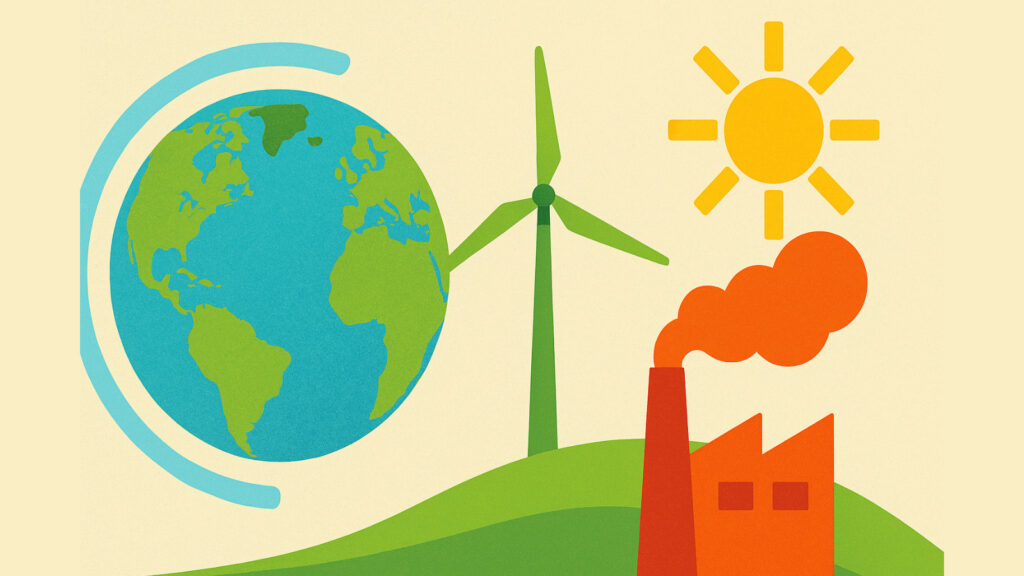
Climate change represents the ultimate global economic challenge, requiring unprecedented coordination and investment while threatening to disrupt established patterns of production, trade, and development. The transition to sustainable practices creates both enormous opportunities and significant risks for businesses, countries, and individuals worldwide.
Physical climate risks already affect economic activity through extreme weather events that damage infrastructure, disrupt supply chains, and reduce agricultural productivity. Rising sea levels threaten coastal cities and industrial facilities, while changing precipitation patterns affect water-dependent industries and regions.
The energy transition requires massive investments in renewable power generation, storage systems, and transmission networks. This shift creates opportunities for countries rich in renewable resources while potentially stranding assets in fossil fuel industries. The International Energy Agency estimates that achieving net-zero emissions requires annual clean energy investments of over $4 trillion through 2030.
Carbon pricing mechanisms are spreading globally as governments attempt to internalize environmental costs into market prices. These systems affect competitiveness between countries and industries, creating incentives for clean technology adoption while potentially causing carbon leakage to unregulated jurisdictions.
Sustainable finance has emerged as a major force in global capital markets, with investors increasingly considering environmental, social, and governance factors in their decisions. Green bonds, sustainability-linked loans, and ESG investing criteria are reshaping how companies access capital and measure success.
Circular economy principles are gaining adoption as businesses and governments seek to reduce waste and improve resource efficiency. These approaches require redesigning products, processes, and business models to minimize environmental impact while potentially creating new economic opportunities.
Table 11: Climate and Sustainability Economic Indicators (2024)
| Sustainability Metric | Global Value | Trend Direction |
|---|---|---|
| Clean Energy Investment | $4.2 trillion | Rising 15% annually |
| Carbon Markets Value | $0.9 trillion | Expanding coverage |
| Green Bond Issuance | $0.5 trillion | Growing institutional adoption |
| Sustainable Finance Assets | $35.3 trillion | Mainstream integration |
| Circular Economy Market | $4.8 trillion | Early stage development |
Source: International Energy Agency, Climate Bonds Initiative
Conclusion: The Global Economy’s Building Blocks and the Road Ahead
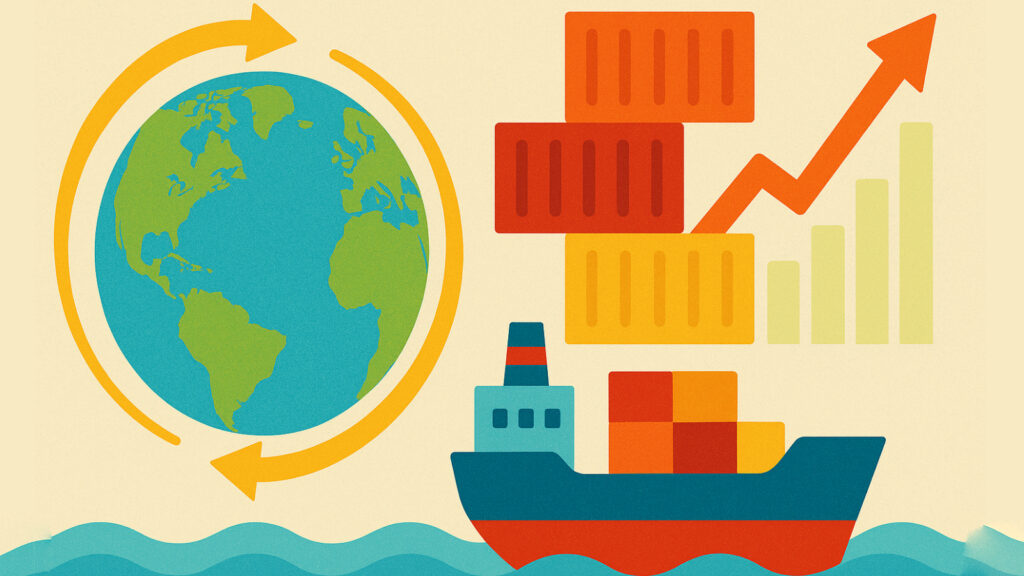
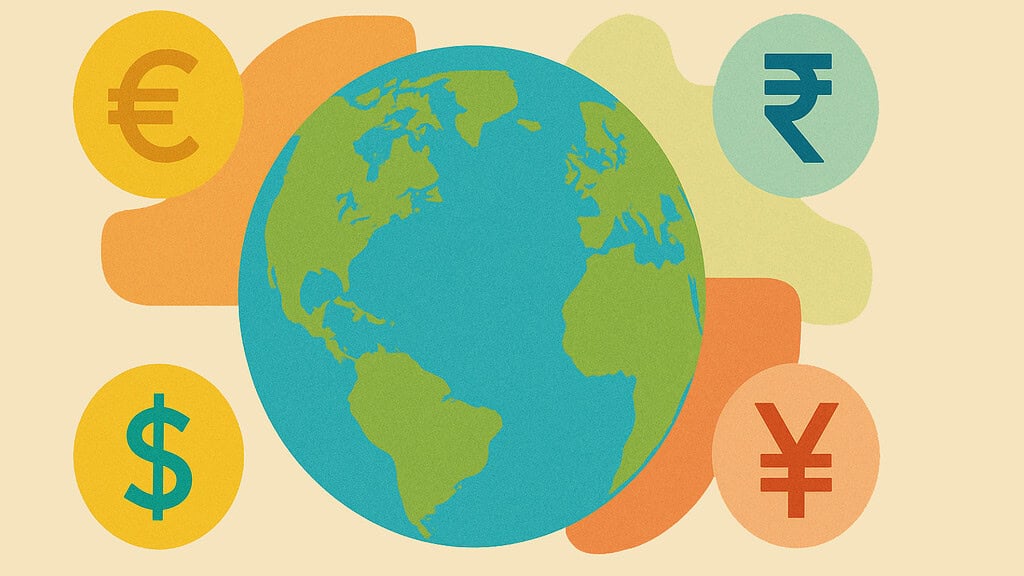
The global economy emerges from the dynamic interaction of these ten building blocks, each influencing and being influenced by the others in ways that create both opportunities and challenges for the world’s eight billion inhabitants. Trade flows enable specialization and efficiency, financial systems provide the capital for growth and development, while human migration connects cultures and fills labor market needs across borders.
Technology accelerates these connections and creates new possibilities, even as natural resource constraints and climate change force adaptations in how we produce and consume. Institutions provide stability and coordination mechanisms, though they must evolve to address emerging challenges like cybersecurity threats and climate change. Supply chains create efficiency but also vulnerability, while geopolitical tensions can override economic logic and fragment global integration.
Demographic changes reshape workforces and consumer markets predictably but with profound implications for social systems and economic structures. Climate change represents an overarching challenge that affects all other building blocks and requires unprecedented global cooperation to address effectively.
Understanding these interconnections helps explain why local events can have global consequences and why international cooperation remains essential despite rising nationalism and protectionism in many countries. The COVID-19 pandemic demonstrated how quickly disruptions can spread through global networks, but it also showed the potential for rapid collaboration in developing solutions.
Looking ahead, the global economy will likely become more complex rather than simpler as new technologies, environmental constraints, and geopolitical tensions reshape traditional patterns. Success will require balancing efficiency with resilience, competition with cooperation, and growth with sustainability. Countries and companies that understand these building blocks and their interactions will be better positioned to navigate the challenges and opportunities ahead.
The future global economy will depend on our collective ability to strengthen beneficial connections while managing risks and ensuring that the benefits of integration reach all participants. This requires both technical expertise and political wisdom to build institutions and agreements that serve human needs while respecting planetary boundaries.
Table 12: Future Global Economy Outlook (2025-2030)
| Economic Driver | Projected Trend | Key Challenges |
|---|---|---|
| Digital Trade Growth | 15-20% annually | Regulatory fragmentation |
| Climate Investment Needs | $130 trillion by 2050 | Financing and coordination |
| Demographic Transition | Accelerating globally | Workforce and social adaptation |
| Supply Chain Evolution | Regionalization and resilience focus | Cost and efficiency trade-offs |
| Geopolitical Fragmentation | Selective decoupling | Reduced efficiency and higher costs |
Source: McKinsey Global Institute, OECD Economic Outlook

